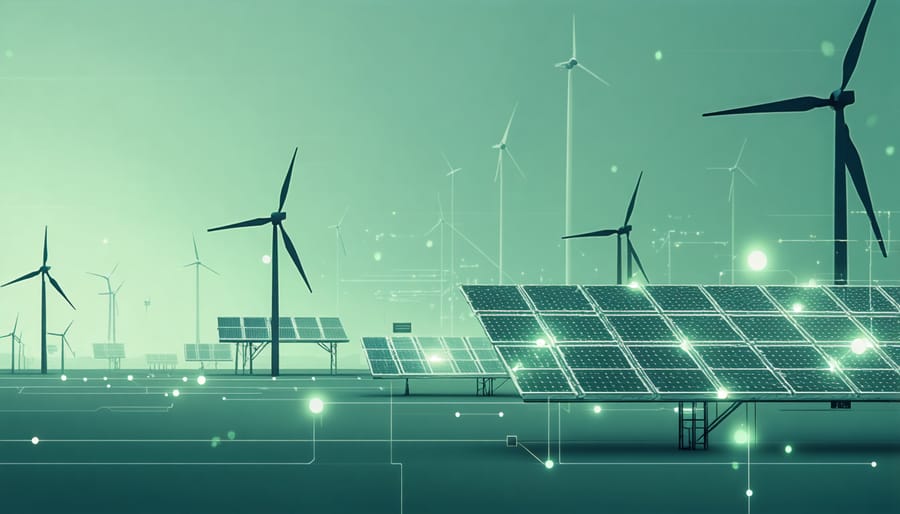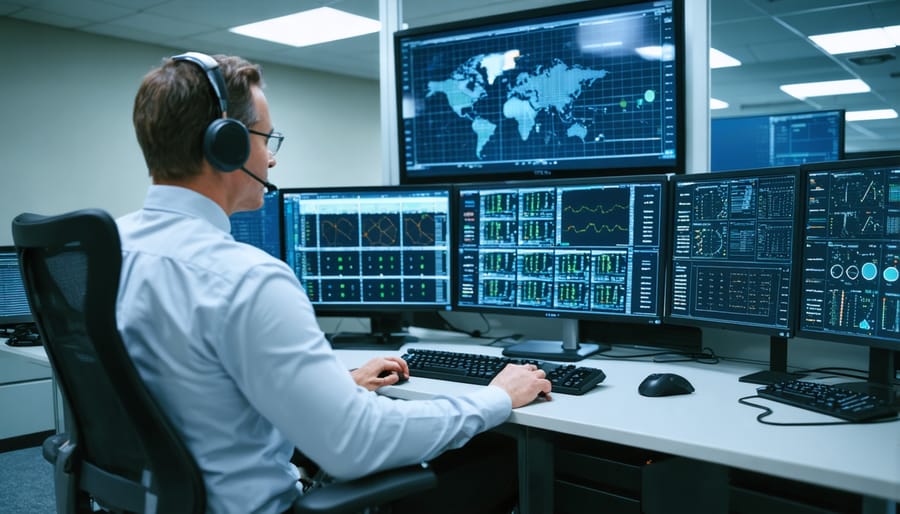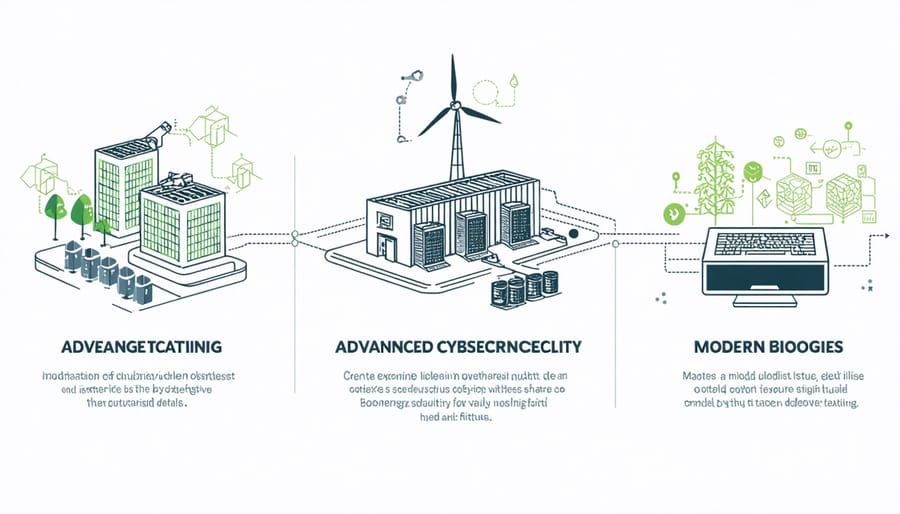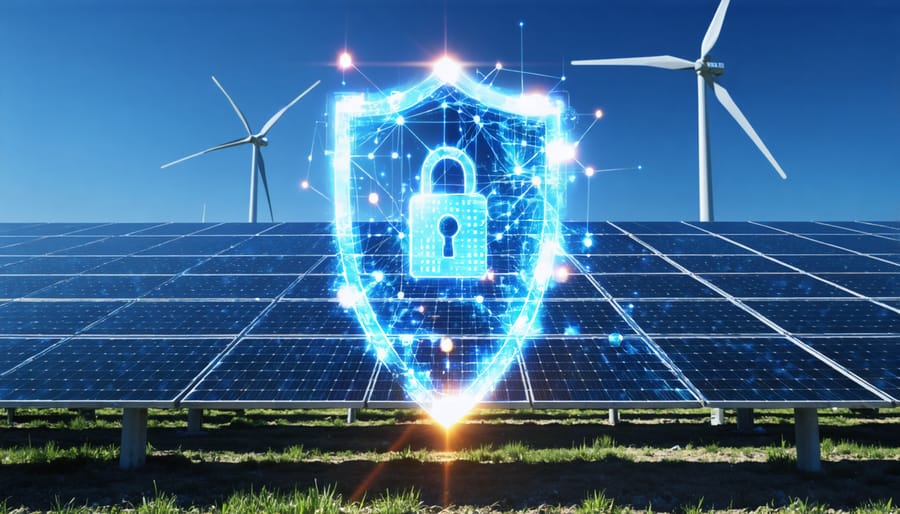As cyber threats to critical infrastructure surge, Australia’s energy sector stands at a pivotal crossroads where digital innovation meets unprecedented vulnerability. Recent attacks on power grids worldwide have demonstrated that cyber resilience isn’t just an IT concern—it’s fundamental to national security and economic stability. In 2023 alone, energy facilities reported a 46% increase in sophisticated cyber attacks, with renewable energy systems emerging as particularly attractive targets for malicious actors.
Australia’s transition to smart grids and distributed energy resources has created new attack surfaces that demand robust cybersecurity frameworks. From solar farms in Queensland to wind installations in Victoria, our renewable energy infrastructure relies heavily on digital systems that must be protected. The interconnected nature of modern energy networks means that a single breach could trigger cascading failures across the grid, potentially affecting millions of homes and businesses.
This evolving threat landscape requires a proactive, multi-layered approach to cybersecurity that balances operational efficiency with robust protection. Energy providers must now navigate complex challenges: protecting legacy systems while integrating new technologies, maintaining regulatory compliance while fostering innovation, and ensuring uninterrupted power supply while defending against increasingly sophisticated cyber threats.
The Evolving Cyber Threat Landscape in Energy Systems

Unique Vulnerabilities in Renewable Energy Systems
Renewable energy systems present unique cybersecurity challenges that require specialized attention. While traditional power plants typically operate in isolated networks, modern renewable facilities are increasingly interconnected, creating multiple entry points for potential cyber threats. Solar farms and wind turbines, equipped with smart sensors and remote monitoring capabilities, are particularly vulnerable to data manipulation and control system breaches.
The distributed nature of renewable energy systems, especially in Australia’s vast landscape, makes implementing smart energy grid defenses more complex. Bioenergy facilities face additional challenges due to their reliance on both physical and digital supply chain management systems. These facilities must protect not only power generation controls but also biomass processing and storage monitoring systems.
Weather-dependent renewables require real-time data exchange for optimal performance, making them attractive targets for cyber attacks. The integration of Internet of Things (IoT) devices and cloud-based management systems, while improving efficiency, also expands the attack surface. Success in protecting these systems relies on implementing multi-layered security approaches that balance accessibility with robust protection, ensuring our renewable future remains secure and reliable.
Recent Cyber Incidents in the Energy Sector
Recent cyber incidents have highlighted the critical importance of protecting our energy infrastructure. In 2021, the Colonial Pipeline attack in the United States served as a wake-up call for the global energy sector, causing widespread fuel shortages and demonstrating how cyber threats can impact daily life. Closer to home, Australian energy providers have reported an increasing number of attempted breaches, with one major utility detecting over 150 suspicious activities in a single quarter of 2022.
What’s particularly concerning is the sophistication of these attacks. The Solar Winds breach affected multiple Australian energy organizations, showcasing how supply chain vulnerabilities can be exploited. Meanwhile, smaller renewable energy installations have faced targeted ransomware attacks, with cyber criminals recognizing the critical role these facilities play in our energy future.
These incidents have sparked positive change, though. The Australian Energy Market Operator (AEMO) has strengthened its cybersecurity framework, implementing robust monitoring systems and conducting regular security drills. Energy providers are increasingly adopting integrated security approaches, combining traditional IT protection with specialized operational technology safeguards.
Building Cyber-Resilient Energy Infrastructure
Essential Security Measures for Energy Facilities
In today’s interconnected energy landscape, protecting our power infrastructure requires a multi-layered approach to security. Modern energy facilities must implement robust cybersecurity measures that go beyond traditional IT security protocols, especially as we transition towards decentralized power grid security systems.
Essential security measures begin with comprehensive access control systems, including multi-factor authentication for both physical and digital access points. Energy facilities should maintain strict separation between operational technology (OT) and information technology (IT) networks, creating air-gaps where necessary to prevent potential cyber threats from crossing system boundaries.
Regular security audits and vulnerability assessments are crucial, with particular attention paid to industrial control systems (ICS) and SCADA networks. These assessments should be conducted by certified professionals who understand the unique challenges of energy infrastructure protection.
Advanced monitoring systems using artificial intelligence can detect unusual patterns and potential threats in real-time, allowing for swift response to security incidents. Additionally, implementing encrypted communications protocols and secure remote access solutions ensures that authorized personnel can safely manage systems while maintaining operational integrity.
Employee training plays a vital role in maintaining security. Regular cybersecurity awareness programs help staff recognize potential threats and follow proper security procedures. This human element, combined with technological solutions, creates a robust security framework that protects our essential energy infrastructure while enabling efficient operations.
Integration of IT and OT Security
In today’s interconnected energy landscape, the convergence of Information Technology (IT) and Operational Technology (OT) systems presents both opportunities and challenges for cybersecurity. Smart grids and renewable energy facilities particularly rely on seamless integration between these two domains, making their security paramount for Australia’s energy future.
Success in this area requires a holistic approach that bridges the traditional gap between IT and OT security teams. Leading Australian energy providers have implemented unified security operations centres (SOCs) that monitor both networks simultaneously, enabling rapid response to threats across the entire infrastructure.
Key integration strategies include implementing zero-trust architectures that verify every access attempt, regardless of its origin, and establishing secure zones between IT and OT networks through properly configured firewalls and demilitarised zones (DMZs). Regular security assessments that consider both domains help identify vulnerabilities at intersection points.
Victorian power utilities have shown particular success in this area, deploying advanced security information and event management (SIEM) systems that provide real-time visibility across both IT and OT environments. These systems have proven crucial in detecting and preventing cyber incidents before they impact operations.
Training programs that cross-skill IT and OT personnel have become increasingly important, ensuring teams understand both the technical and operational impacts of security measures. This collaborative approach has resulted in more robust security protocols and faster incident response times across the sector.

Employee Training and Security Culture
The human element remains one of the most critical factors in maintaining robust cybersecurity within Australia’s energy sector. As our energy workforce development continues to evolve, creating a security-conscious culture has become paramount for protecting our vital infrastructure.
Successful cybersecurity programs start with comprehensive employee training that goes beyond annual compliance sessions. Leading Australian energy providers have adopted innovative approaches, including simulated phishing exercises, interactive workshops, and regular security briefings that keep staff engaged and alert. These programs emphasize practical scenarios that employees might encounter, from suspicious emails to unusual system behavior.
The most effective security cultures develop when organizations foster an environment where staff feel comfortable reporting potential threats without fear of criticism. Many Australian energy facilities have implemented reward systems for identifying security risks and have created dedicated channels for reporting concerns. This approach has proven particularly successful in preventing potential breaches before they occur.
Regular updates and refresher courses ensure that staff stay current with emerging threats and best practices. Energy companies are increasingly incorporating gamification elements into their training programs, making security awareness an engaging part of daily operations rather than a tedious obligation. This shift in approach has led to measurably better outcomes in threat detection and response times across the sector.
Australian Success Stories in Energy Cybersecurity

Bioenergy Facility Security Solutions
Australian bioenergy facilities are implementing robust cybersecurity measures to protect their operations and ensure continuous renewable energy supply. The Yarra Valley Water’s waste-to-energy facility showcases exemplary security protocols, combining physical access controls with advanced digital safeguards. Their multi-layered approach includes biometric authentication for critical areas and encrypted communications for remote monitoring systems.
In Queensland, the Mackay Renewable Biocommodities Pilot Plant employs an innovative security framework that separates operational technology networks from administrative systems. This segregation ensures that potential breaches in office networks cannot compromise crucial production processes. The facility also conducts regular penetration testing and vulnerability assessments, engaging local cybersecurity experts to simulate potential attacks.
Several regional bioenergy plants have adopted the Australian Energy Sector Cyber Security Framework (AESCF), implementing real-time monitoring systems that detect and respond to potential threats. For instance, the Mount Gambier biomass facility uses artificial intelligence-powered security tools to identify unusual patterns in system operations and automatically isolate affected components.
Industry leaders are also fostering collaboration through the Bioenergy Security Alliance, where facilities share threat intelligence and best practices. This cooperative approach has proven particularly effective in protecting smaller operations that might otherwise lack resources for comprehensive security measures. Regular staff training programs and cyber incident response drills ensure that human factors remain a strong link in the security chain.
Collaborative Security Initiatives
In Australia’s energy landscape, collaborative security initiatives have proven to be game-changers in strengthening cybersecurity defenses. The Australian Energy Market Operator (AEMO) has established a groundbreaking partnership with leading cybersecurity firms and energy providers, creating a shared threat intelligence network that has successfully prevented numerous potential attacks.
A stellar example is the Victorian Energy Security Partnership, where major utilities like AusNet Services and Energy Australia joined forces with cybersecurity experts from the Australian Cyber Security Centre. This collaboration resulted in the development of an advanced early warning system that detected and neutralized multiple cyber threats before they could impact critical infrastructure.
The Western Australian Renewable Energy Alliance showcases another successful model, where wind and solar facilities partnered with local tech companies to create a unified security operations center. This initiative not only improved threat response times by 60% but also developed innovative solutions for protecting renewable energy assets.
International partnerships have also played a crucial role. Australian energy providers are actively participating in the Global Energy Cyber Security Alliance, sharing best practices and threat intelligence with counterparts worldwide. These cross-border collaborations have helped establish robust security protocols that address emerging threats while maintaining operational efficiency.
These partnerships demonstrate how combining industry expertise with cybersecurity knowledge creates more resilient energy systems, ensuring reliable power delivery while protecting against evolving cyber threats.
Future-Proofing Australia’s Energy Security
Emerging Technologies and Solutions
The energy sector is witnessing a revolutionary shift in cybersecurity technologies, with artificial intelligence and machine learning leading the charge. These innovations are particularly crucial for adaptive energy systems that require robust protection against evolving threats.
Blockchain technology is emerging as a game-changer, offering decentralised security solutions that make it significantly harder for attackers to compromise energy infrastructure. Australian utilities are already implementing blockchain-based smart contracts to secure peer-to-peer energy trading and grid management systems.
Zero-trust architecture is gaining traction, requiring verification at every step of digital interactions within energy systems. This approach, combined with advanced endpoint detection and response (EDR) tools, provides comprehensive protection against sophisticated cyber threats.
Quantum-resistant encryption is being developed to safeguard against future quantum computing threats, ensuring long-term security for critical energy infrastructure. Additionally, automated threat hunting tools powered by AI are helping organisations identify and neutralise potential threats before they can cause damage.
These emerging technologies are complemented by improved security awareness training platforms that use virtual reality and gamification to better prepare energy sector staff for cyber challenges.
Policy and Industry Recommendations
To strengthen cybersecurity in Australia’s energy sector, we recommend implementing a multi-layered approach that combines policy reforms with industry-led initiatives. Energy providers should adopt the Essential Eight framework, endorsed by the Australian Cyber Security Centre, as their baseline security standard. This includes regular system updates, multi-factor authentication, and robust backup procedures.
Government agencies should establish mandatory reporting requirements for cybersecurity incidents and provide tax incentives for companies investing in cybersecurity infrastructure. Additionally, creating a national energy sector cyber response team would enable rapid coordination during security breaches.
For industry stakeholders, we recommend developing sector-specific security standards, implementing regular staff training programs, and conducting quarterly security audits. Energy companies should also participate in information-sharing networks to stay ahead of emerging threats.
Small and medium-sized energy providers can start by conducting risk assessments, upgrading legacy systems, and establishing incident response plans. Partnering with cybersecurity firms for regular penetration testing and vulnerability assessments is also crucial.
By following these recommendations, Australia’s energy sector can build resilience against cyber threats while maintaining operational efficiency.
As Australia accelerates its transition to renewable energy, maintaining robust cybersecurity measures becomes increasingly critical. The interconnected nature of modern energy systems, particularly in renewable infrastructure, creates both opportunities and vulnerabilities that we must proactively address.
Our journey towards a sustainable energy future cannot compromise on security. The successful integration of renewable energy sources depends heavily on sophisticated digital systems, smart grids, and automated controls – all of which must be protected with the same vigilance we apply to traditional energy infrastructure.
The good news is that Australia’s energy sector has shown remarkable resilience and adaptability. From solar farms in Queensland to wind facilities in South Australia, we’re seeing innovative approaches to combining clean energy generation with state-of-the-art cybersecurity protocols. These success stories demonstrate that security and sustainability can go hand in hand.
Looking ahead, the key to maintaining this balance lies in continuous adaptation and investment in both technological and human resources. Energy companies must foster a culture of cybersecurity awareness while implementing the latest protective measures. Regular training, system updates, and security assessments should be as fundamental to operations as maintaining physical infrastructure.
By prioritising cybersecurity in our renewable energy transition, we’re not just protecting critical infrastructure – we’re securing Australia’s sustainable future. The path forward requires ongoing collaboration between industry stakeholders, government bodies, and cybersecurity experts to ensure our clean energy systems remain resilient and secure.

